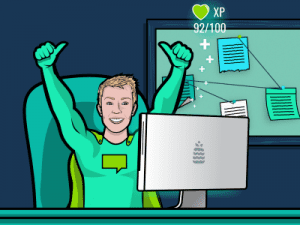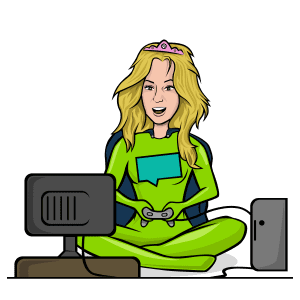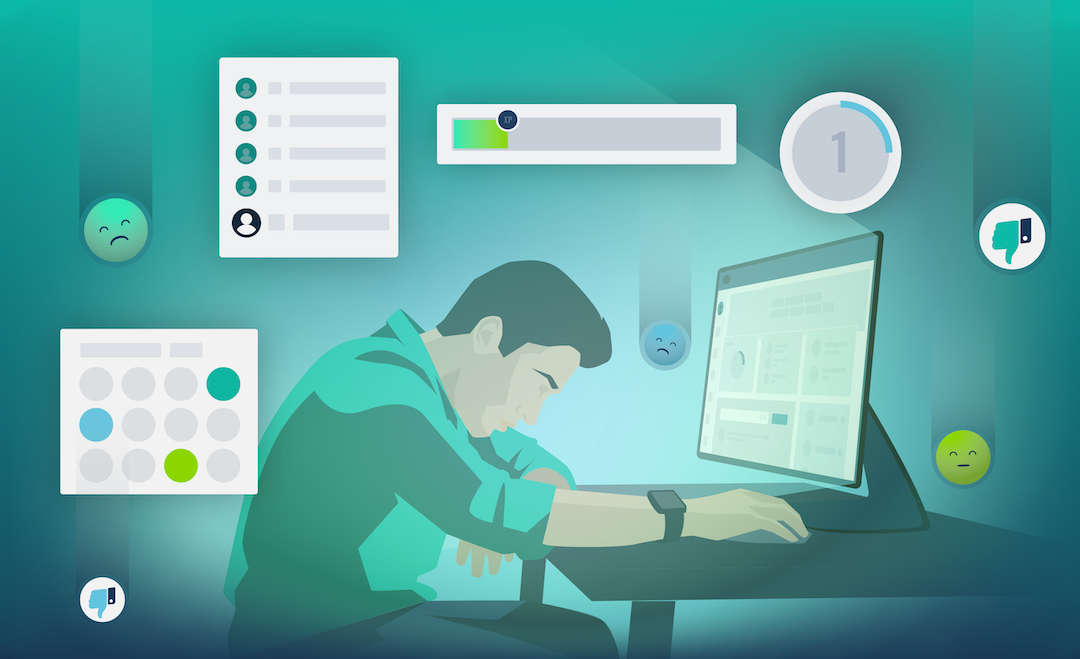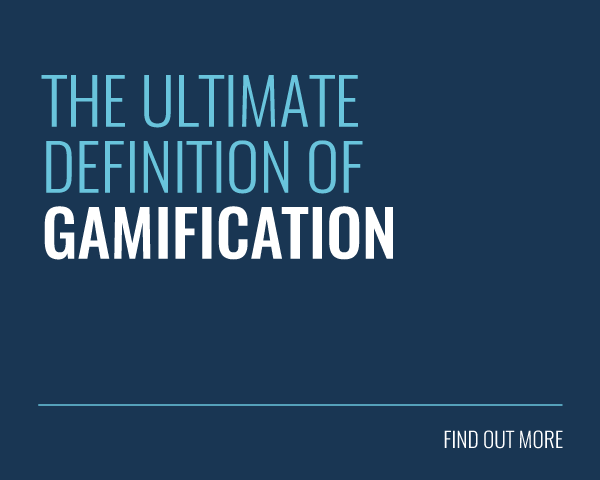 Gamification is when gaming mechanics are used to enhance traditionally non gaming environments. Today, car insurance companies use gamification to stop speeding. Big brands offer customer rewards to increase sales. Even health services use gamification to encourage healthy eating.
Gamification is when gaming mechanics are used to enhance traditionally non gaming environments. Today, car insurance companies use gamification to stop speeding. Big brands offer customer rewards to increase sales. Even health services use gamification to encourage healthy eating.
So, why is gamification picking up fans faster than Sonic the Hedgehog in Power Sneakers? Let’s look at some of the benefits of gamification.
Firstly, see how Juliette applies game mechanics to learning technology solutions:
Engaging Brain Chemistry
Gamification is a powerful engagement tool that creates real behaviour change by working with your brain chemistry. How does it work? Learning feels awesome because it triggers a heady rush of happy hormones. This is our brain’s way of saying: “Whatever you just did, keep doing it!” So when learners enjoy training they feel engaged and want more. However, when training is boring the feel-good factor vanishes. Gamification helps put the joy back into your online training!
Fun

Remember those times you were hooked on Candy Crush, got aching thumbs from playing Mario Kart too long, or simply had fun stacking Tetris blocks. The sense of accomplishment, competition and rewards makes gaming fun. Gamification features, such as Levels, Leaderboards and Experience Points (XP), add these extra layers of fun into your training. These tools let learners track their progress, collect rewards and compete with colleagues.
Rewards
Surprises and rewards add a little extra joy to the learning journey and boost engagement. Learners earn Badges and XP as they progress through training content and interact with the LMS features. Each time they take a positive action on the platform, such as downloading content, a virtual reward pops up on screen. It’s a simple way of awarding regular recognition for taking part.
Recognition
Research shows saying ‘thank you’ for a job well done increases employee engagement by 30%. Virtual rewards feel extra special when they’re personalised and meaningful. For example, on the Academy LMS managers can give team members Praise Badges when they’ve gone above and beyond the call of duty. Praise Badges have Epic Meaning because they show learners their development and contribution is valued.

Short Feedback Cycles
Employees don’t want to wait until their annual appraisal for feedback or recognition. They want feedback now , when it’s relevant. Gamification features like unlockable Achievements give the learner instant feedback whenever they do something positive, like logging in for the 100th time. You can also assign Badges to specific pieces of content, like eLearning or Assessments. Instantly receiving a shiny new badge doesn’t just shorten the feedback cycle – it removes it altogether!
Real World Benefits
Badges and XP are all very nice but do you know what’s really exciting? Icecream! Rollercoasters! Duvet days! Gamification can be used to deliver your employee benefits programme, giving learners the chance to exchange virtual rewards for real world prizes. 100 XP could earn a free ice cream. 1000XP could get them that theme park trip (if they dare!). Someone with 50 Praise Pages has surely earned a day off to lounge around in their onesie!
Real-life rewards trump virtual rewards any day. Fortunately, the two aren’t mutually exclusive. You can use gamification to dish out real world rewards.
Shared Success
Few things trigger that warm, fuzzy feeling more that celebrating success together. However far apart your teams are, gamification allows them to celebrate their colleagues’ achievements on the LMS. Virtual rewards show up on each learner’s profile area and pop up on the LMS newsfeed. This means every time someone achieves a Praise Badge or XP, their colleagues can congratulate them with a virtual round of applause or a simple thumbs up!
Emotional Resilience
Research from veteran game designer, Jane McGonigal, shows games can alter emotional responses and improve resilience. This matters because resilience is strongly linked with engagement at work. By building training around a gaming culture you can boost learners’ resilience and confidence. If they know there’s a reward or the chance to level-up at the end of a tough training assignment, they’ll feel more determined to succeed. Instead of frustration, when faced with a complex topic, learners will rise to the challenge!
Epic Meaning

Video games are engaging because they make gamers feel like their actions matter. Will they defeat the dragon and save the princess or is it ‘game over’? Fictional lives depend on them! This is something we call ‘Epic Meaning’.
You can use gamification features on the LMS to add layers of Epic Meaning that show learners how their development benefits the company mission. This lets you customise Badges and Level banners to fit the company brand, purpose and the learner’s achievement.
Clear Goals
What made ‘Pokemon Go!’ such a huge hit? It tapped into the insatiable collector within us all. You can use badges in a similar way on the LMS! The badges earned are displayed in each learner’s virtual badge cabinet. But learners beware! The badges yet to be achieved, also appear here. This turns the badges into goals, as learners seek to fill the gaps. The badge hunt drives learners to explore the LMS and complete training to claim their prize – that missing badge!

Clear Learning Pathways
Levels let learners track their progress. The progress bar shows them how far they’ve come and what they need to do to level-up. Clearly defined progress like this gives learners a sense of accomplishment and spurs them on to do what’s needed to reach the next level. If a learner knows they need to take just one more small action to reach the giddy heights of ‘Level Awesome’ they will be more likely to put the effort in.
Healthy Competition

You could say levels are like a competition with yourself. What could be more motivating than a race against yourself? A competition with fellow learners of course! Leaderboards let learners see how their achievements stack up against their colleagues’. Each learner is ranked on the LMS leaderboards according to how many badges or XP they’ve achieved. This means there’s only one way to beat your friends (and rivals) to the top – engage, train and learn, to earn rewards!
Visible Engagement Patterns
By attaching virtual rewards to positive learner behaviour on the LMS you can easily identify who is engaging and who isn’t. So, if someone is still on the ‘Newbie Ninja’ level and only has 50 XP after three years at the company, there’s a high chance they aren’t engaging and don’t feel very motivated. On the other hand, a learner who tops the leaderboard is more likely to be storming through the content and sharing everything they know on the LMS messageboards. Once you spot a trend, good or bad, you can do something about it!
Collaboration
You can promote collaboration and knowledge sharing by awarding Badges to learners who comment and post on the LMS. This encourages important social learning. Once learners know they can earn more rewards by sharing their wisdom, the conversations will start flowing. Before you know it, they’ll be fully fledged social butterflies and will need less encouragement to share and chat.
Learner Feedback
Asking your learners for regular feedback is the best way to improve their training. The truth may be scary but it’s worth it! Use virtual rewards to incentivise everyone to offer up their reviews. You could invite learners to pick their favourite content or review a module to win a special badge. Their feedback will make it clear which content rocks and which flops! This helps your learners find the best content and it helps you identify areas in need of improvement.

Identify Expertise
Gamification helps you find the brainiacs hiding in your midst! Points are awarded to the most prolific contributors to the LMS discussion groups. This means the learner who has answered the most questions will have the most points and be top of the discussion group leaderboard. Then it’s easy to spot who really knows their stuff and award these masterminds ‘expert status’ on the LMS. This is an effective way to celebrate expertise and ensures learners know who to ask for help.
Strong Team Culture
Leaderboards aren’t all about pitting individual learners against each other. They also encourage strong team bonds. Learners can use team leaderboards to see how their whole team stacks up against other teams or regions. So your sales superstars could compare their combined score against their rivals in marketing. Or your Eastern office may want to take on the West Coast bunch. This motivates each team member to make a personal effort and boost their team’s ranking – after all no one wants to let their team down!
Gamified Work Culture
You can use gaming mechanics outside of the LMS to engage and motivate your teams. You could broadcast the Leaderboards on TVs throughout the office. Or you could create physical leaderboards showing who’s on track to smash this month’s targets. Video games retailer, GAME took the joy of virtual rewards a step further. Once their sales staff collect a certain amount of Badges on the LMS, they earn a real-life ‘Pin’ to attach to their lanyard. This shows colleagues and customers alike who has really earned their stripes.
Return on Investment (ROI)
Now for the hard figures! By using gamification to create fun and engaging online learning, you ensure learners complete training content and achieve lasting behaviour change. The result? ROI shoots up! Don’t just take our word for it. Here’s how three of our clients used gamification to secure ROI:
GAME
GAME are the leading video games retailer in Spain and the UK. They launched their gamified LMS, ‘GAME Learning Zone’, in 2016. Since its launch, completion rates have soared, with an 89% completion rate on their sales scenario training alone. This led to a 94.3% uplift in the average customer basket. Read GAME’s full case study here.
EE
EE are the UK’s biggest 4G network. EE’s gamified LMS, ‘The Digital Academy’, has made a massive impact and created real behaviour change. 92% off EE staff say ‘The Digital Academy’ has increased their digital skills. Read EE’s full case study here.
Hendrick Automotive Group
Hendrick Automotive Group is an automotive dealership with over 10,000 employees throughout the United States. The company’s gamified LMS, H.A.L.O., uses gamification and social features to engage learners and encourage return visits. ‘H.A.L.O.’, is now used by 8 times more employees than their previous online learning solution. Read Hendrick’s full case study here.
As we’ve discovered, gamification can have huge benefits for online training. If you’re eager to see gamification in action, sign up for a tour around our award-winning Academy LMS. Click the button below to get started!









